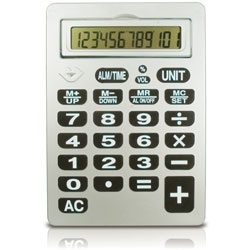Low-Tech & Mid-Tech Adaptions For Completing Math Assignments:
Low- Tech Options Include:
- Math Fact Rubber stamps: These stamps help students master their fundamental math facts using something fun, like stamps. These stamps come in addition facts, subtraction facts, multiplication facts and division facts. These would be fun to use as a review and to help a child complete an assignment!

Math Fact Rubber Stamps - A manipulative number line
- Laminated addition and multiplication tables
Mid-Tech Options Include:
- Large Calculator with oversized buttons: These are useful for students who lack motor control.

Large Calculator with oversized buttons. - Talking Calculators: These are useful because they can "help students with learning disabilities check their work by reading aloud every keystroke that the student enters" (). This is also useful for students with visual impairments.Dell, A.G., Newton, D.A., & Petroff, J.G.

The See 'N' Solve Talking Calculator - "Coin Abacus": The "coin abacus" "contains keys that are shaped and sized just like real coins; they are designed to teach basic money counting" ().Dell, A.G., Newton, D.A., & Petroff, J.G.

Coin Abacus - "Coin-U-Lator": Just like the "coin abacus", the "coin-u-lator", "contains keys that are shaped and sized just like real coins; they are designed to teach basic money counting" ().Dell, A.G., Newton, D.A., & Petroff, J.G.

The "Coin-U-Lator"
To learn more about the Coin-U-Lator, click THIS link!
As a student with a math disability, I think I would have, and still would, benefit from using the above low-tech and mid-tech adaptions to help me complete math assignments! As far as young children go, I love the idea of the "coin abacus" and the "Coin-U-Lator" these mid-tech tools not only seem like a lot of fun to play with, but they are also very useful to help reinforce students on how to add or subtract coins!Dell, A.G., Newton, D.A., & Petroff, J.G. (2012). Assistive Technology in the Classroom. Boston. PEARSON.


No comments:
Post a Comment